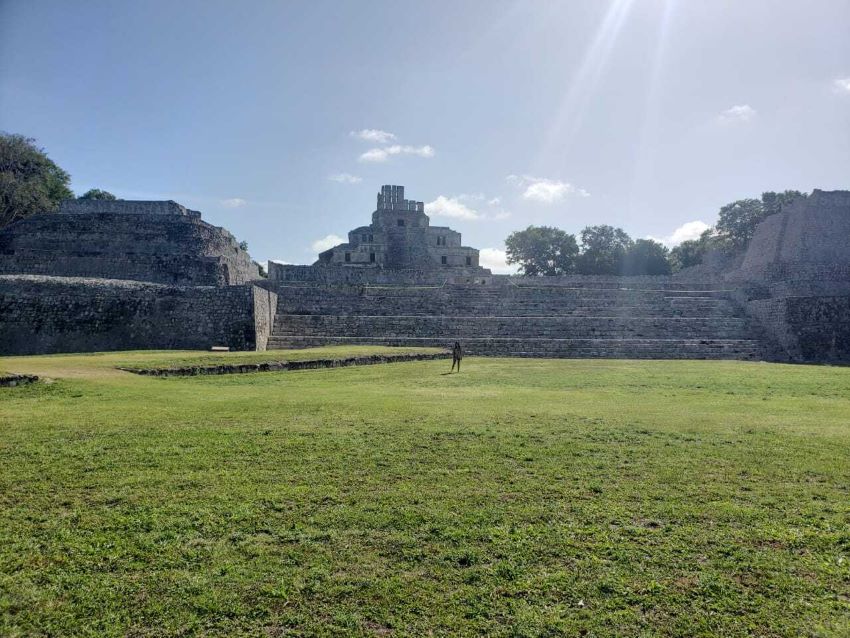The Maya archaeological sites in the states of Yucatán and Quintana Roo are popular tourist attractions, but the fascinating sites in the state of Campeche continue to be hidden gems.
Situated 55 kilometers from the city of Campeche, Edzná is an ancient Maya city surprisingly empty of visitors. For travelers looking to explore well-preserved pre-Hispanic structures without the crowds, it’s a great choice. We made a day trip from Mérida.
Edzná means “The House of the Itzáes.” The inhabitants were known as the Itzáes, named after the Maya lineage, Itzá. Discovered in 1906, Edzná is thought to have been occupied from B.C. 600 to A.D. 1450, and an important regional capital during A.D. 400–1000. Edzná had maintained close ties with the powerful Maya city of Calakmul and been a part of the Calakmul polity during the Late Classic period. The city is also known for its advanced hydraulic system for the collection, storage and distribution of rainwater for farming and other purposes.
Right at the site’s entrance is an interesting small sculpture museum with several stelae, including figures of the rulers of Edzná. Following the museum is a beautiful walk through the jungle up to the site.
The National Institute of Anthropology and History (INAH) has placed notices at the main areas with historic facts and other important information that are extremely useful to understand the background of this ancient city. There are several incredible structures and even visible original paint in a few places.

We entered the site by the Patio of the Ambassadors, named after the foreign ambassadors who visited Edzná because of a restoration work program sponsored by the United Nations and other international organizations to employ Guatemalan refugees in Mexico. A notable spot here is the Platform of Knives, a platform structure with remains of chambers. It is named for the flint knives discovered there in the 20th century. As you look ahead toward the Main Plaza, which is a large open space resembling a present-day sports field and surrounded by spectacular buildings and pyramids, it’s easy to envision the glory of Edzná in its heyday.
East of the Main Plaza is the Great Acrópolis, a quadrangular space with five structures built on a massive platform measuring 160 meters on each side and around eight meters in height. There is a grand staircase to access it, and the platform offers stunning views across the site. It is not difficult to imagine that this was the prime area of Edzná, which is thought to have spanned 25 square kilometers.
But perhaps the true highlight of the Acrópolis and the entire site is the Pyramid of Five Floors, measuring 31.5 meters in height and thought to have been a residential building for the city’s leaders as well as a shrine. There are many rooms on the different levels, a roof comb — the structure that tops pyramids in monumental Mesoamerican architecture — and heliographs at the base of the pyramid. You will not tire of observing this majestic structure from different angles. Climbing the pyramid itself is not allowed, however.
Right in front of the main pyramid is the Solar Platform, where it’s believed astronomical phenomena were observed. To the south is the Temple of the Moon, a seven-tiered pyramid with a few rooms on top. There are also three temples oriented towards the north, northwest and southwest. Climbing is usually allowed on these buildings, but with the ongoing pandemic, all structures here are currently cordoned off to visitors.
To the west of the Main Plaza is a large structure called Nohochná, or Casa Grande. This structure resembles the grandstand of a modern stadium and covers the entire west side of the Main Plaza. Nohochná, thought to have been an administrative building, has a view of the Acrópolis that is simply breathtaking.
Additionally, to the Acrópolis’ south is a smaller quadrangular square on a platform called The Small Acrópolis. Its four pyramid structures have been identified as Edzná’s oldest buildings. The most significant of the four is the Temple of the Reliefs, named after the relief carvings discovered on the stairways. The platform measures 70 meters on each side and around five meters in height.

Another notable structure, and an absolute must-see at this site, is the Temple of the Masks, discovered in 1988, to the west of the Small Acrópolis. There are two magnificent stucco masks at the base of this temple, of the young Sun God at sunrise and the old Sun God at sunset.
Stucco is very fragile, and so it is seldom preserved in such great condition. The well-preserved masks, with spots of original paint — and the temple as a whole — will be a delight for art and sculpture enthusiasts.
The ball court and the ceremonial South Temple to the south of the Main Plaza are also worth seeing. The South Temple is a beautiful five-tiered pyramid with rooms on top. The ball court has two parallel platforms with a narrow playing area in between. The large trees and the greenery in this area are very refreshing, especially in the heat. There are several other structures to explore at the site, including a section called the Old Sorcerer Complex that is around one kilometer from the Acrópolis.
This Maya city has been remodeled multiple times over 1,500 years and is a great place for architecture enthusiasts to observe different building styles.
Thilini Wijesinhe, a financial professional turned writer and entrepreneur, moved to Mexico in 2019 from Australia. She writes from Mérida, Yucatán. Her website can be found at https://momentsing.com/
